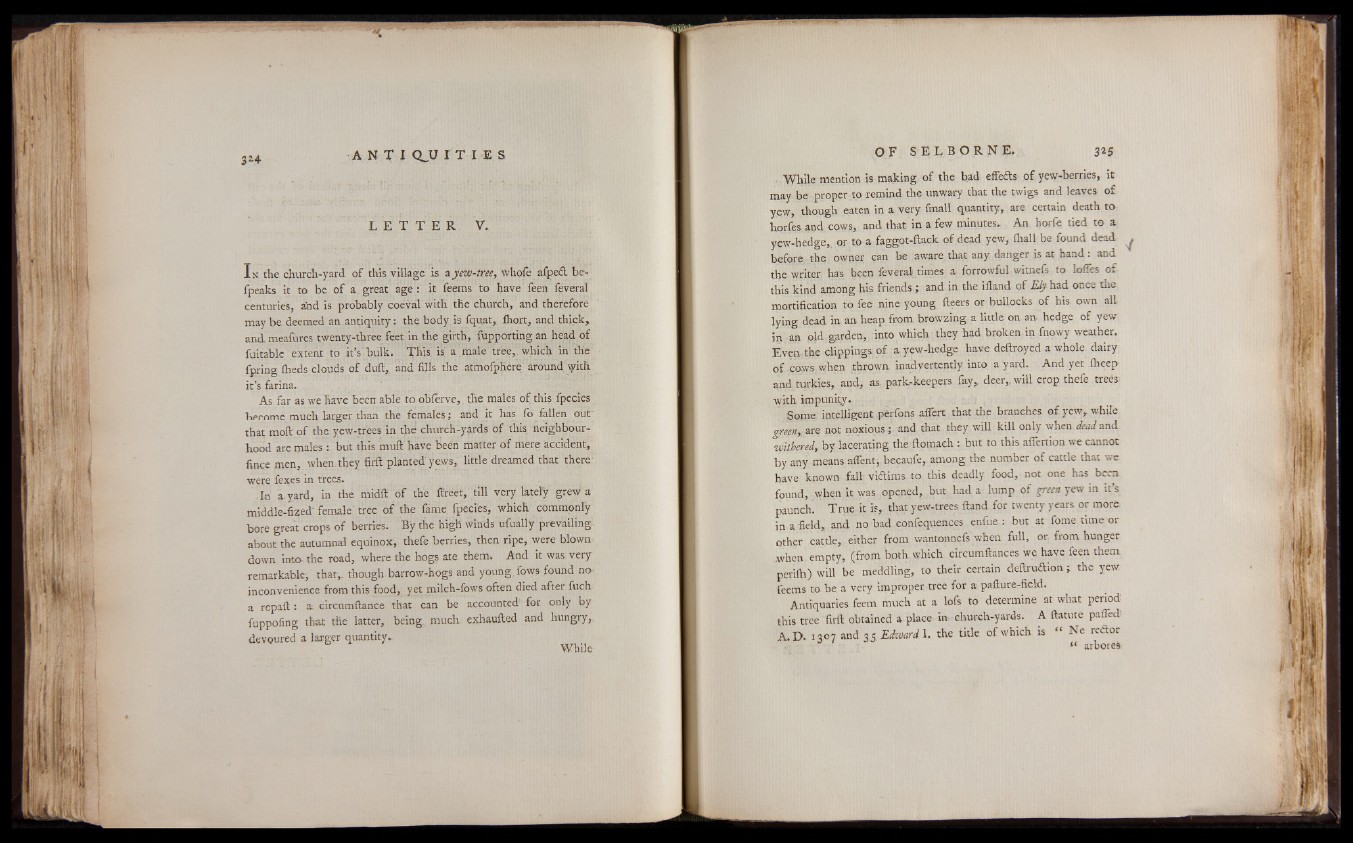
324 A N T I Q_U r T I E S
L E T T E R V.
In the church-yard of this village is a yew-tree, whofe afped be-
fpeaks it to be of a. great age: it feems to have feen feveral
centuries, arid is probably coeval with the church, and therefore
may be deemed an antiquity: the body, is fquat,, Ihort, and thick,
and meafures twenty-three feet in the girth, fupporting an head of
fuitable extent to it’s bulk. This, is a .male tree,, which in the
fpring Iheds clouds of dull, and fills the atmofpfiere around vyith
it’s farina.
As far as we have been able to obferve, the males of this fpecies
become much larger than the females; and it has fo fallen out
that mod of the yew-trees in the church-yards of this neighbourhood
are males but this mull have been matter of mere accident,
fince men, when, they firft planted yews,, little .dreamed that there
were fexes in trees.
In a. yard, in the midft of the ftreet, till very lately grew a
middle-fized' female tree of the fame, fpecies, which commonly
bore great crops of berries. By the high winds ufually prevailing
about the autumnal equinox, thefe berries, then ripe, were blown-
down into the road, where the bogs ate them. And it was very
remarkable, that,, though barrow-hogs and young fows found noinconvenience
from this food, yet milch-fows often died aftei fuch
a repaft : a circumftance that can be accounted for only by
fuppofing that the latter, being much exhaufted and hungry,,
devoured a larger quantity..
While
O F S E L B O R N E . 325
While mention is making of the bad effe&s of yew-berries, it
may be proper to remind the unwary that the twigs and leaves of
yew, though eaten in a very fmall quantity, are certain death to
horfes and cows, and that in a few minutes- An horfe tied to a
yew-hedge, or to a faggot-flack of dead yew, fhall be found dead
before, the owner can be aware that any danger is at hand : and.
the writer has been feveral times a forrowful witnefs to lofles of
this kind among his friends ; and in the ifland of Ely had once the
mortification to fee nine young fleers or bullocks of his own all
lying dead in an heap from browzing a little on an. hedge of yew
in an old garden, into which they had broken in fnowy weather.
Even, the clippings: of a yew-hedge have deftroyed a whole dairy
of cows; when thrown inadvertently into a yard. And yet fheep
and turkies, and, as. park-keepers fay, deer,, will crop thefe trees;
with impunity. . . j .
Some intelligent pCrfons alfert that the branches of yew, while
green,, are not noxious ; and that they will kill only when dead and
withered, by lacerating the ftomach : but to this affertion we cannot
by any means affent, becaufe, among the number of cattle that we
have known fall vidtims to this deadly food, not one has been
found, when it was opened, but had a lump of green yew in it’s
paunch. True it is, that yew-trees Hand for twenty years or more
in a field, and no bad confequences enfue : but at fome time or
other cattle, either from wantonnefs when full, or from hunger
.when empty, (from both which circumfiances we have feen them
perilh) will be meddling, to their certain deftrudlion ; the yew
feems to be a very improper tree for a pafture-field.
Antiquaries feem much at a lofs to determine at what period
this tree firft obtained a place in church-yards. A ftatute paffed
A .D . 19.07 and 3 5 Edward l . the title of which is “ Ne reftor
~. • • t( arbores;
'Z